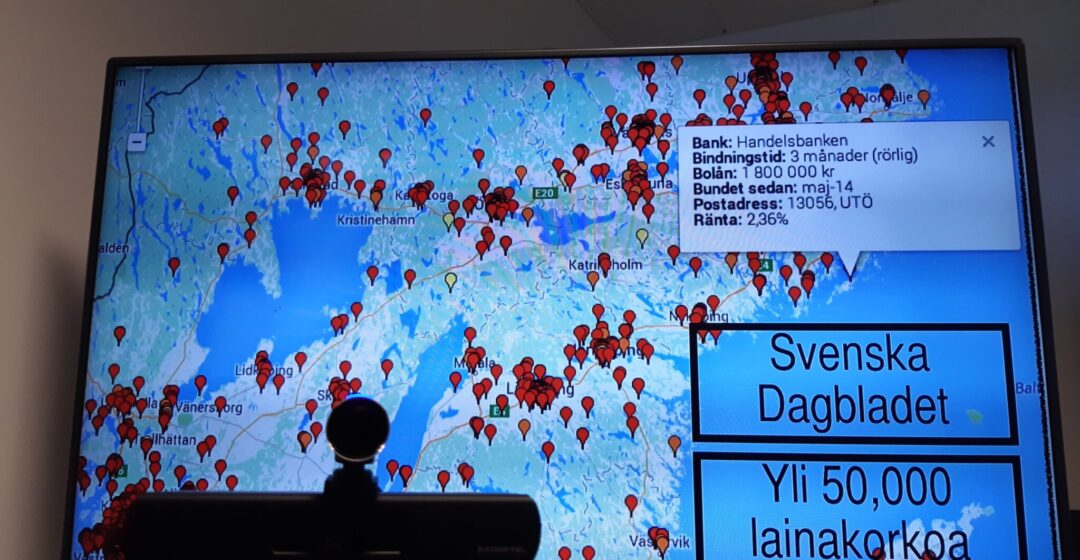Image: Webinar in progress, with Tanja Aitamurto’s presentation underway.
Predicting the future and being ready for it is difficult. This is something journalists and their employers have learned the hard way over the past twenty or so years. The media field is in turmoil, being reshaped on a tectonic scale by new platforms and networks. Amidst the upheaval, professional journalism is struggling to regain its footing. More is to come – but what, when and to what effect?
Last week we faced a group of journalists with an impossible task. Reporters, freelancers, editors, head editors, CEO’s, and a few brave summer interns met online for a series of fast-paced speeches and discussions, organised by the Disrupting the Media Scene project. The formidable task: to envision journalism’s future in the riptide of new technologies and shifting audience relationships.
The session was expertly primed by Tanja Aitamurto, of University of Illinois at Chicago, Johannes Koponen, of the think tank Demos Helsinki, and Jarno Koponen, of Finland’s PSB Yleisradio. Tanja spoke of the different roles audiences have -and could have- in journalism; Johannes argued journalistic organisations have failed to “ask the right questions” in facing up to current challenges; and Jarno spoke, from experience, of how to design journalistic products that make use of modern technology and are appealing to audiences.
With these guiding thoughts our participants were thrown into small groups and asked to envision the future: Where are the opportunities, the threats and the mysteries? What knowledge still needs to be produced, what wisdom yet awaits application?
Obvious shortcomings and puzzling opportunities
Of the three discussion themes, first and arguably most heatedly discussed was economy. Could new technology help professional journalism recoup some of its lost profit margins and bring in the needed resources? The short answer, according to our participants, seems to be “no”. Instead, the journalists underscored the value of quality content – whatever that may be for today’s audience. There was, however, one problem to which the participants hoped to find a technology-borne solution: how to make paying for journalism smooth and easy?
Second, we invited our journalist informants to discuss changes in the journalism-audience relationship. This discourse was muted, as if the question itself was hard to grasp let alone answer. Historically, journalists have been used to keeping their audiences at an arm’s length – as sources of information and (often unwanted) feedback. Modern technology or sensibilities do not seem to have changed this much – and the participants saw little room for expanding audiences’ role. If anything, new measurement software allows journalists to understand audiences better, but still at a safe distance.
Last, we asked journalists what drives or hinders the adoption of new technologies at newsrooms. A lot was said about this topic, but some themes kept popping up. On one hand, journalists know they desperately need to adapt in order to reach and maintain audiences. On the other, newsrooms struggle with dwindling resources, which makes it ever more difficult to invest time and money into developing new ways of doing journalism. There is also a lot of organisational inertia -sunken costs and entrenched routines- that elevate the threshold for innovation. Furthermore: management sometimes tries to “sell” new tech to journalists with the wrong pitch: journalists are interested in quality, not efficiency or novelty for novelty’s sake. Emphasizing the latter over the former can stoke resistance.
It’s too late to sideline audiences
Can any conclusions be drawn from these discussions? Without claiming definitive representation, it seems journalists are very cognizant of their field’s need for renewal – at least in terms of adopting new technology and inventing better ways to monetize journalism.
There seems to be less enthusiasm around changing the journalism-audience relationship. This is understandable, as journalists often are adamant about the inviolability of their autonomy. Granting laypeople a greater role within the profession might seem like heresy. However, audience can hardly be kept “out” of journalism: arguably, much of today’s journalism (if not professional journalism) is created or co-created by audiences. Tip-offs, crowdsourcing, analysis, interpretation and fact-checking – audiences are already doing all this.
Will professional journalistic organisations see ways of co-opting these processes?
The Disrupting the Media Scene project is a collaboration between the University of Vaasa’s InnoLab and Åbo Akademi University’s Experience Lab. The project is funded by the Helsingin Sanomat Foundation.
Author: Ville Manninen has a PhD in journalism studies and is currently working at InnoLab with the Disrupting the Media Scene project.




